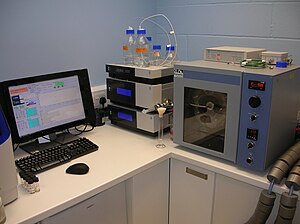Countercurrent chromatography
Countercurrent chromatography (CCC) is a type of liquid-liquid chromatography that utilizes two immiscible liquid phases: a stationary phase and a mobile phase. Unlike traditional chromatography techniques that use a solid stationary phase, CCC relies on the partitioning of solutes between two liquid phases, which allows for the separation of compounds based on their differing solubilities.
Principle[edit | edit source]
The principle of countercurrent chromatography is based on the partition coefficient of solutes between two immiscible liquid phases. One phase acts as the stationary phase, while the other serves as the mobile phase. The stationary phase is retained in the column by centrifugal force, while the mobile phase is pumped through the column. As the solutes travel through the column, they partition between the two phases, leading to their separation.
Types of Countercurrent Chromatography[edit | edit source]
There are several types of countercurrent chromatography, including:
- High-speed countercurrent chromatography (HSCCC)
- Centrifugal partition chromatography (CPC)
- Droplet countercurrent chromatography (DCCC)
Each type has its own unique mechanism for retaining the stationary phase and facilitating the separation process.
Applications[edit | edit source]
Countercurrent chromatography is widely used in various fields, including:
- Pharmaceutical industry for the purification of natural products and active pharmaceutical ingredients (APIs)
- Food industry for the separation and analysis of food additives and contaminants
- Environmental science for the analysis of pollutants and toxins
- Biotechnology for the purification of proteins, peptides, and other biomolecules
Advantages[edit | edit source]
Some of the key advantages of countercurrent chromatography include:
- High recovery rates due to the absence of a solid stationary phase, which minimizes sample loss
- Ability to handle large sample volumes
- Flexibility in choosing different solvent systems to optimize separation
- Scalability from analytical to preparative and industrial scales
Limitations[edit | edit source]
Despite its advantages, countercurrent chromatography also has some limitations:
- Complexity in selecting the appropriate solvent system
- Longer separation times compared to some other chromatographic techniques
- Requirement for specialized equipment and expertise
Related Pages[edit | edit source]
- Chromatography
- Liquid-liquid extraction
- Partition coefficient
- Centrifugal partition chromatography
- High-speed countercurrent chromatography
See Also[edit | edit source]
References[edit | edit source]
External Links[edit | edit source]
Search WikiMD
Ad.Tired of being Overweight? Try W8MD's physician weight loss program.
Semaglutide (Ozempic / Wegovy and Tirzepatide (Mounjaro / Zepbound) available.
Advertise on WikiMD
|
WikiMD's Wellness Encyclopedia |
| Let Food Be Thy Medicine Medicine Thy Food - Hippocrates |
Translate this page: - East Asian
中文,
日本,
한국어,
South Asian
हिन्दी,
தமிழ்,
తెలుగు,
Urdu,
ಕನ್ನಡ,
Southeast Asian
Indonesian,
Vietnamese,
Thai,
မြန်မာဘာသာ,
বাংলা
European
español,
Deutsch,
français,
Greek,
português do Brasil,
polski,
română,
русский,
Nederlands,
norsk,
svenska,
suomi,
Italian
Middle Eastern & African
عربى,
Turkish,
Persian,
Hebrew,
Afrikaans,
isiZulu,
Kiswahili,
Other
Bulgarian,
Hungarian,
Czech,
Swedish,
മലയാളം,
मराठी,
ਪੰਜਾਬੀ,
ગુજરાતી,
Portuguese,
Ukrainian
Medical Disclaimer: WikiMD is not a substitute for professional medical advice. The information on WikiMD is provided as an information resource only, may be incorrect, outdated or misleading, and is not to be used or relied on for any diagnostic or treatment purposes. Please consult your health care provider before making any healthcare decisions or for guidance about a specific medical condition. WikiMD expressly disclaims responsibility, and shall have no liability, for any damages, loss, injury, or liability whatsoever suffered as a result of your reliance on the information contained in this site. By visiting this site you agree to the foregoing terms and conditions, which may from time to time be changed or supplemented by WikiMD. If you do not agree to the foregoing terms and conditions, you should not enter or use this site. See full disclaimer.
Credits:Most images are courtesy of Wikimedia commons, and templates Wikipedia, licensed under CC BY SA or similar.
Contributors: Prab R. Tumpati, MD

